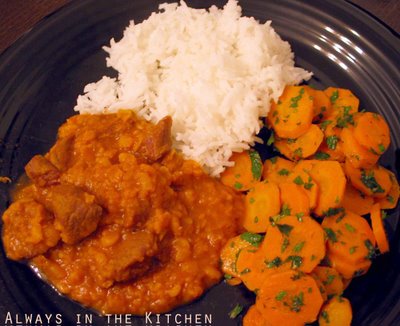
I didn't experience Persian cuisine until I was an adult, and took to it immediately. The deeply flavourful, slow-cooked stews and luscious pilaffs made me want to immediately start incorporating recipes into my repertoire, and I've been gradually adding them ever since.
This particular lamb and okra stew came from researching which flavours would have dominated some of the common stews before the introduction of tomatoes, which have been thoroughly adopted into many dishes. The intense flavour of dried limes/lemons was the obvious answer, in combination with the typical fragrant and nuanced blends of spices. This recipe does contain potatoes, optionally, which is also an introduced ingredient, but otherwise draws on some of the most traditional flavours of its region.
Go ahead and use fresh okra if you like, but try to get the small ones.
Persian Inspired Lamb and Okra Stew
(Khoresht e Baamieh)
Serves 4
500 grams stewing lamb, diced
1.5 tablespoons canola or olive oil, divided
2 medium yellow onions, finely diced
5 cloves garlic, minced or pressed
1 teaspoon turmeric
1/4 teaspoon ground cumin
1/8 teaspoon cinnamon
1/4 teaspoon paprika
1/2 teaspoon coarse salt
1/2 teaspoon black pepper
2 - 3 cups water/vegetable broth/light stock
3-4 dried limes
400 grams frozen petit okra
200 grams waxy nugget potatoes, halved or quartered (optional)
2 branches rosemary
2 tablespoons chopped dill to garnish (alternatively sumac)
In a medium-large soup pot over medium heat, heat one tablespoon of the canola oil and add the onion and garlic. Stir and sauté until the onion is translucent and just starts to stick to the bottom of the pan, and then add the lamb. Sprinkle with salt, pepper, turmeric, cumin, paprika, and cinnamon (if using), and continue to sauté until the lamb colours slightly. Add the water, and bring to a simmer. Add a couple of dried limes if you like, hammered open. Reduce the heat and cover, and then simmer for an hour and a half, until the lamb is tender.
Rinse the okra and set aside. In a separate skillet, heat the remaining half tablespoon of oil until it shimmers, and then add the okra into the hot skillet. Stir fry the okra until they are bright green (add an extra pinch of salt as you fry them), about 3 minutes. Pour the okra into the stew, and add a bit of lemon juice or sumac, especially if you are not using dried limes. Stir through, cover the pot, and reduce the heat to low. Simmer for about 45 minutes, until all of the flavours permeate the okra.
Serve with plain rice or flatbread.
It reheats very well, in fact it's even better the next day. Freezer friendly, if properly sealed.













